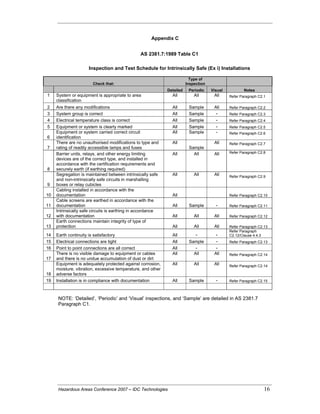The Best Guide To Roar Solutions
The Best Guide To Roar Solutions
Blog Article
The 5-Second Trick For Roar Solutions
Table of ContentsThe Facts About Roar Solutions Revealed3 Easy Facts About Roar Solutions ShownThe 45-Second Trick For Roar Solutions
In such an ambience a fire or surge is feasible when 3 basic problems are fulfilled. This is commonly described as the "hazardous location" or "burning" triangle. In order to secure setups from a potential explosion a technique of evaluating and identifying a possibly hazardous location is required. The function of this is to make certain the proper choice and installation of tools to ultimately protect against a surge and to guarantee safety and security of life.(https://linktr.ee/thomascarrillo4740)
No equipment needs to be installed where the surface area temperature level of the devices is higher than the ignition temperature of the provided hazard. Below are some common dirt unsafe and their minimal ignition temperature. Coal Dust 380C 225C Polythene 420C (thaws) Methyl Cellulose 420C 320C Starch 460C 435C Flour 490C 340C Sugar 490C 460C Grain Dust 510C 300C Phenolic Resin 530C > 450C Aluminium 590C > 450C PVC 700C > 450C Residue 810C 570C The chance of the danger existing in a concentration high adequate to trigger an ignition will certainly differ from place to location.
Dangerous location electrical tools perhaps designed for usage in greater ambient temperatures. Area Repair Service By Authorised Personnel: Difficult screening may not be required nevertheless specific treatments might need to be adhered to in order for the equipment to preserve its 3rd party ranking. Each item of devices with an unsafe rating need to be assessed individually.
The Definitive Guide for Roar Solutions
The tools register is an extensive data source of tools records that consists of a minimum set of fields to determine each item's location, technological criteria, Ex lover category, age, and ecological data. The proportion of Detailed to Close examinations will certainly be identified by the Tools Risk, which is assessed based on ignition danger (the likelihood of a source of ignition versus the likelihood of a combustible ambience )and the unsafe location classification
( Zone 0Area 1, or 2). Executing a robust Risk-Based Inspection( RBI )approach is crucial for making certain compliance and security in managing Electrical Devices in Hazardous Areas( EEHA).
What Does Roar Solutions Do?

In terms of explosive danger, a hazardous location is an atmosphere in which an eruptive environment is present (or may be anticipated to be present) in quantities that call for special precautions for the building and construction, installation and use of tools. eeha. In this write-up we discover the difficulties dealt with in the workplace, the threat control procedures, and the needed competencies to function securely
It is a consequence of modern life that we make, store or deal with a range of gases or liquids that are deemed flammable, and a range of dirts that are regarded combustible. These substances can, in specific problems, create eruptive ambiences and these can have significant and unfortunate effects. Most of us know with the fire triangle eliminate any type of one of the 3 components and the fire can not occur, however what does this mean in the context of dangerous locations? When damaging this down into its simplest terms it is basically: a combination of a particular amount of launch or leak of a certain substance or product, blending with ambient oxygen, and the presence of a resource of ignition.
In a lot of instances, we can do little regarding the levels of oxygen in the air, but we can have significant impact on resources of ignition, as an example electric equipment. Dangerous locations are documented on the hazardous location category illustration and are identified on-site by the triangular "EX" sign. Below, amongst various other key info, areas are divided right into 3 types depending upon the risk, the probability and period that an explosive atmosphere will exist; Area 0 or 20 is considered the most unsafe and Zone 2 or 22 is deemed the least.
Report this page